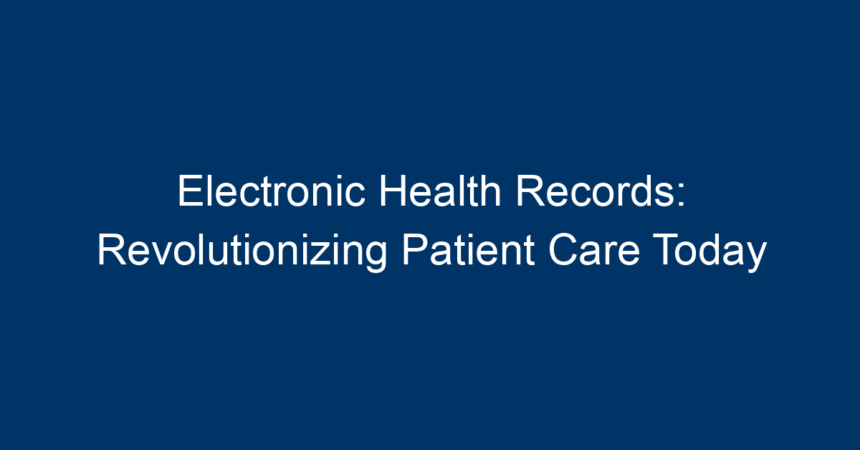In the digital age, the healthcare industry is experiencing a transformative shift. At the forefront of this revolution are electronic health records (EHRs), a technology that is reshaping how patient information is managed, shared, and utilized. By replacing traditional paper-based systems, EHRs not only enhance the efficiency of healthcare providers but also improve the quality of patient care. In this article, we will explore the various ways EHRs are revolutionizing patient care, the challenges and benefits they present, and actionable insights for embracing this vital technology.
What are Electronic Health Records?
Electronic Health Records are digital versions of patients’ paper charts. They contain comprehensive information about a patient’s medical history, diagnoses, medications, treatment plans, immunization dates, allergies, radiology images, and laboratory results. EHRs facilitate the real-time sharing of health information among healthcare providers, making it easier to provide coordinated and effective patient care.
Key Features of EHRs
EHRs come packed with features that streamline healthcare operations:
- Accessibility: Authorized healthcare professionals can access patient data from anywhere, improving the speed and accuracy of treatment.
- Interoperability: EHR systems are designed to share information seamlessly across different healthcare platforms, leading to more integrated care.
- Data Analytics: EHRs allow for the collection and analysis of patient data, helping to identify trends and support evidence-based decision-making.
Enhancing Patient Care with EHRs
1. Improved Coordination Among Providers
One of the most significant advantages of electronic health records is the ability to enhance coordination among various healthcare professionals. When a patient visits a specialist, that provider can easily access the patient’s complete health history, test results, and medications without unnecessary delays. This comprehensive view minimizes the risk of duplicative tests and conflicting treatments, ensuring a smoother care experience.
2. Boosting Patient Engagement
EHRs often include patient portals that allow individuals to view their health records, schedule appointments, and communicate with their healthcare providers. This transparency promotes patient engagement and empowers individuals to take a more active role in their healthcare decisions.
3. Reducing Medical Errors
EHRs contribute significantly to reducing medical errors. With electronic prescriptions, the chances of misreading a handwritten prescription are nearly eliminated. Additionally, EHRs can alert healthcare providers about potential drug interactions or allergies, enhancing patient safety.
4. Streamlining Administrative Tasks
EHRs automate various administrative tasks, such as billing and insurance claims processing, freeing up time for healthcare staff to focus on patient care. This efficiency can translate into shorter wait times for patients and a smoother overall experience.
Challenges of Implementing Electronic Health Records
While the benefits of EHRs are substantial, transitioning from paper to digital systems is not without its challenges.
1. High Initial Costs
Implementing an EHR system involves significant initial investment in software, hardware, and training. Smaller practices may find these costs prohibitive, leading to slower adoption rates.
2. Training Requirements
Staff members must be adequately trained on how to use EHR systems effectively. This can require time and resources which may not be readily available, particularly in smaller healthcare settings.
3. Data Privacy and Security Concerns
With the digitization of sensitive medical information, the risk of data breaches has heightened. Healthcare providers must invest in robust cybersecurity measures to protect patient information, which can add to operational costs.
Future Trends in Electronic Health Records
As technology continues to evolve, so do electronic health records. Here are some anticipated trends that may shape the future of EHRs:
1. Increased Interoperability
As healthcare systems recognize the importance of sharing information for patient outcomes, future EHR systems will likely prioritize interoperability, enabling seamless communication across various platforms.
2. Integration with Wearable Technology
The rise of wearable health technology, such as fitness trackers and smartwatches, may lead to more integrated health records. These devices can provide real-time health data to EHR systems, offering healthcare providers a comprehensive view of a patient’s health status.
3. Artificial Intelligence and Machine Learning
The integration of AI and machine learning can significantly enhance EHR functionalities, from predictive analytics to personalized medicine. These technologies can analyze vast amounts of data to offer insights and recommendations tailored to individual patients.
Conclusion
The advent of electronic health records is a game changer for the healthcare industry, significantly improving patient care and operational efficiency. While challenges exist, the benefits far outweigh them. For healthcare providers looking to enhance their practice, embracing EHR technology is crucial. This transition not only streamlines processes but also fosters patient engagement, coordination, and safety.
Actionable Insights
- Conduct a Needs Assessment: Evaluate your practice’s specific needs regarding EHR systems to choose the best fit.
- Invest in Training: Ensure that all staff members receive adequate training on using the EHR system effectively.
- Prioritize Security: Implement strong cybersecurity policies to safeguard patient information.
- Encourage Patient Participation: Use patient portals to promote patient engagement and facilitate communication.
- Stay Updated on Trends: Keep abreast of new technologies and practices in EHR systems to maintain a competitive edge.
By leveraging the strengths of EHRs and addressing potential challenges, healthcare providers can truly revolutionize patient care, paving the way for a healthier future.




